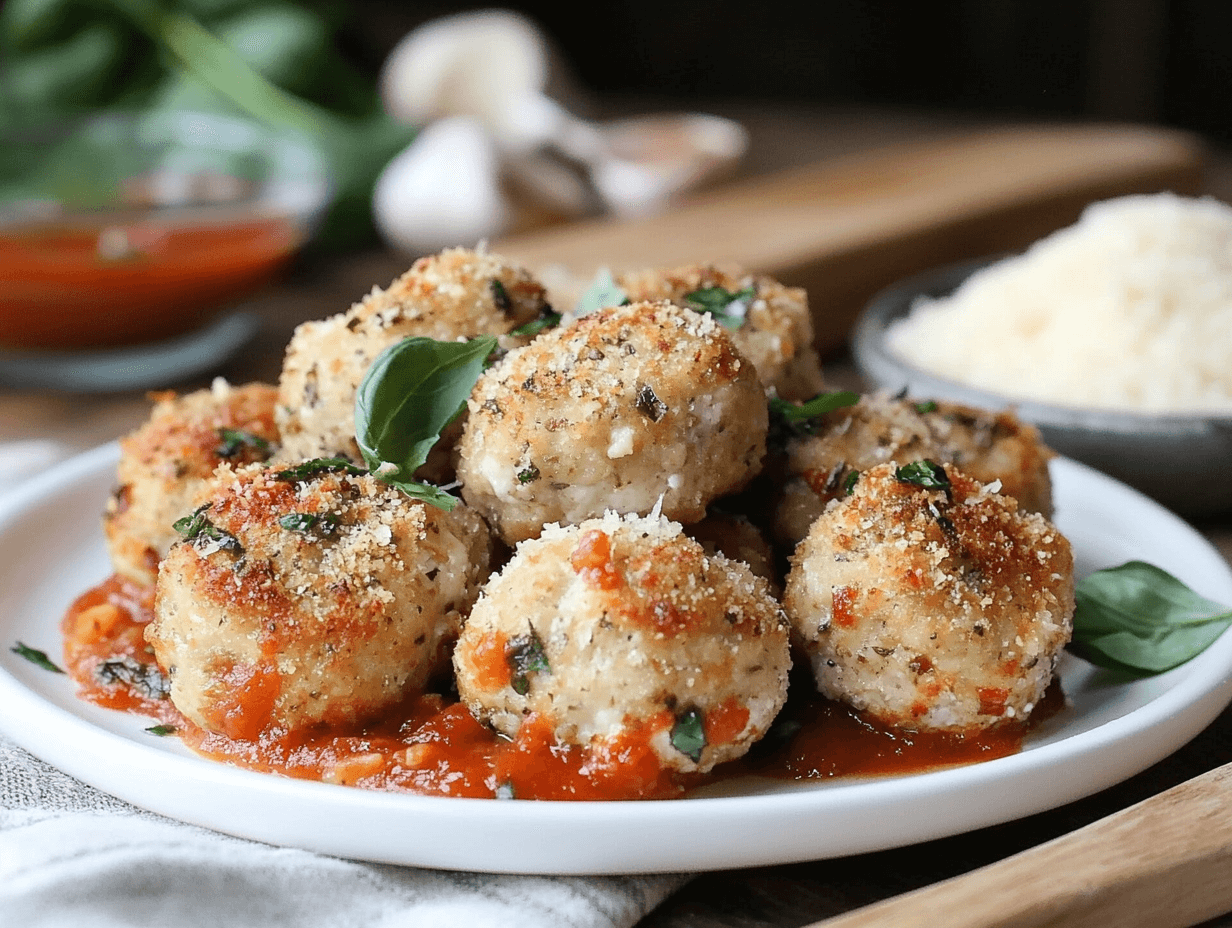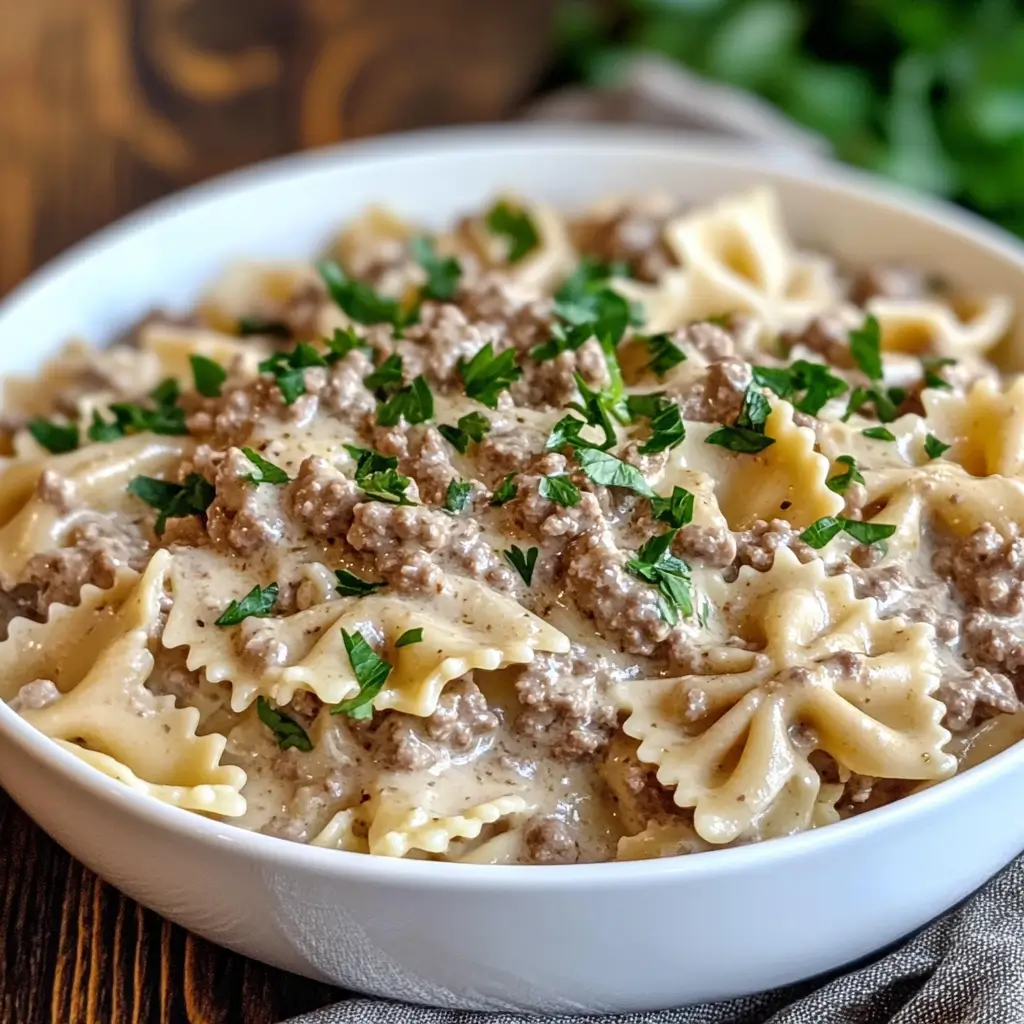Table of contents
Chicken ricotta meatballs are a delightful twist on traditional meatballs, combining the mild, lean flavor of chicken with the creamy richness of ricotta cheese. These tender, juicy meatballs are perfect for a weeknight dinner or a crowd-pleasing appetizer. Moreover, their versatility allows them to pair beautifully with a variety of sauces, from classic marinara to a light lemon-butter drizzle.
Unlike beef or pork-based meatballs, chicken ricotta meatballs are lighter and less greasy. Consequently, they are an excellent choice for those looking for a healthier alternative. The addition of ricotta cheese not only enhances the flavor but also ensures a moist and tender texture that melts in your mouth. Whether you serve them over pasta, with a side salad, or as a standalone dish, these meatballs are sure to impress.
Ingredients Overview
To create the perfect chicken ricotta meatballs, it’s crucial to use the right combination of ingredients. Each component plays a unique role in flavor, texture, and overall success of the dish. Furthermore, understanding substitutions ensures you can tailor the recipe to fit various dietary needs.
Core Ingredients
- Ground Chicken
- Why it’s important: Ground chicken is the star of the dish, providing a mild, neutral base that absorbs flavors beautifully. Opt for a mix of light and dark meat to ensure a balance of moisture and flavor.
- Substitutions: Ground turkey can be used for a similar lean option, while ground pork or beef will create a richer variation.
- Ricotta Cheese
- Why it’s important: Ricotta adds creaminess and moisture, ensuring the meatballs are tender and not dry. Full-fat ricotta works best, but part-skim can be used for a lighter option.
- Substitutions: Cottage cheese blended until smooth can replace ricotta in a pinch.
- Breadcrumbs
- Why it’s important: Breadcrumbs bind the meatballs and help maintain their shape during cooking. They also absorb moisture to create a soft, light texture.
- Substitutions: Use panko for extra lightness or almond flour for a gluten-free option.
- Eggs
- Why it’s important: Eggs act as a binder, holding all the ingredients together.
- Substitutions: For an egg-free version, consider using flaxseed meal mixed with water or a commercial egg replacer.
- Parmesan Cheese
- Why it’s important: Adds a salty, nutty flavor that enhances the dish’s overall taste. Grated Parmesan is preferred for even distribution.
- Substitutions: Pecorino Romano or nutritional yeast for a dairy-free alternative.
- Seasonings
- Common choices include garlic powder, onion powder, dried oregano, parsley, salt, and black pepper. These spices create a flavorful base that complements the ricotta and chicken.
Optional Enhancements
Fresh Herbs: Basil, chives, or dill provide a fresh, aromatic touch to the dish.
Lemon Zest: This adds a subtle citrus brightness, enhancing the overall flavor.
Chili Flakes: For a spicy kick, a pinch of chili flakes can elevate the flavor profile.
Ingredient Preparation Tips
- Draining Ricotta: If your ricotta is particularly watery, drain it in a fine-mesh sieve or cheesecloth to prevent the meatballs from becoming too soft.
- Breadcrumb Texture: Toasting breadcrumbs before mixing can deepen their flavor.
- Seasoning Check: Cook a small test patty before forming all the meatballs to ensure seasoning is balanced.
With these ingredients in hand, you’re ready to start creating delicious chicken ricotta meatballs!
Preparation Techniques

Creating chicken ricotta meatballs involves several essential steps, from mixing the ingredients to forming the perfect shape. These steps ensure that your meatballs are flavorful, moist, and consistent in texture.
Step-by-Step Preparation Guide
- Gather Ingredients
Before starting, measure and prepare all ingredients. For example, mince garlic and herbs finely and grate Parmesan cheese freshly for enhanced flavor. - Mix the Ingredients
Combine ground chicken, ricotta, breadcrumbs, eggs, Parmesan, garlic, and seasonings in a large bowl. Be sure to mix gently, as overmixing can make the meatballs dense. - Test the Mixture
Heat a small skillet, cook a tiny portion of the mixture, and taste it. If needed, adjust the seasoning before proceeding. - Form the Meatballs
Using a tablespoon or cookie scoop, portion out the mixture evenly. Then, gently roll each portion into a round ball. Aim for 1.5-inch balls to balance tenderness and cooking time. - Chill the Meatballs
Place the shaped meatballs on a parchment-lined baking sheet and refrigerate them for 20–30 minutes. This step ensures they firm up and maintain their shape during cooking.
Common Mistakes to Avoid
- Overworking the Mixture
- Kneading or mixing too much can lead to tough, rubbery meatballs. Always mix until just combined.
- Skipping the Chill Time
- Without chilling, the meatballs may fall apart during cooking, especially in sauces.
- Uneven Sizing
- Meatballs of varying sizes will cook unevenly, leaving some undercooked and others dry.
Advanced Tips for Perfect Meatballs
- Moisture Balance
- If the mixture feels too wet, add breadcrumbs one tablespoon at a time.
- If too dry, add a splash of milk or a dollop of ricotta.
- Flavor Boosting Add-Ins
- For an extra punch of flavor, try adding sun-dried tomatoes, finely chopped spinach, or a bit of crumbled feta cheese.
- Make Ahead
- You can prepare the meatballs a day ahead and store them in the refrigerator, covered tightly. Alternatively, freeze them raw for up to three months.
By following these preparation steps, you’ll create a base for meatballs that are tender, flavorful, and ready to be cooked to perfection.
Cooking Methods
Once your chicken ricotta meatballs are prepared, the next step is to cook them to golden perfection. The cooking method you choose depends on your personal preference, the flavor profile you’re aiming for, and how much time you have. Below, we’ll explore three popular methods: baking, frying, and simmering.
Baking the Meatballs
Why Bake?
Baking is one of the healthiest and easiest ways to cook chicken ricotta meatballs. It requires less oil and ensures even cooking.
Steps for Baking:
- Preheat your oven to 400°F (200°C).
- Line a baking sheet with parchment paper or aluminum foil for easy cleanup. Spray lightly with cooking oil to prevent sticking.
- Arrange the meatballs on the sheet, spacing them evenly.
- Bake for 20–25 minutes, turning them halfway through for even browning.
- Check doneness with a meat thermometer; the internal temperature should reach 165°F (74°C).
Pro Tips:
- For a golden crust, broil the meatballs for the last 2–3 minutes.
- Use a wire rack on top of the baking sheet to allow heat to circulate under the meatballs for extra crispness.
Frying the Meatballs
Why Fry?
Frying gives the meatballs a crisp, golden exterior while keeping the inside tender and juicy. It’s a slightly more indulgent option but delivers maximum flavor.
Steps for Frying:
- Heat a few tablespoons of neutral oil (e.g., vegetable or canola oil) in a large skillet over medium-high heat.
- Place the meatballs gently into the pan, leaving enough space between them to turn easily.
- Cook for 2–3 minutes per side until golden brown. Use tongs or a spatula to rotate them.
- Reduce the heat to medium and cook for an additional 5–7 minutes to ensure they’re fully cooked through.
Pro Tips:
- Drain the meatballs on a paper towel to remove excess oil before serving.
- Avoid overcrowding the pan to maintain a consistent temperature and prevent steaming.
Simmering in Sauce
Why Simmer?
Simmering meatballs in sauce allows them to absorb the sauce’s flavors, resulting in a rich and cohesive dish. This method is perfect for pairing with pasta or serving as a standalone dish with crusty bread.
Steps for Simmering:
- Prepare your favorite sauce (e.g., marinara, creamy Alfredo, or a spicy arrabbiata) in a deep skillet or saucepan.
- Bring the sauce to a gentle simmer over medium heat.
- Add the raw or pre-seared meatballs to the sauce, ensuring they are fully submerged.
- Cover the pan and simmer for 20–25 minutes, stirring occasionally to prevent sticking.
- Check doneness with a meat thermometer or slice one meatball open to ensure it’s fully cooked.
Pro Tips:
- If simmering raw meatballs, make sure the sauce is not boiling, as this can cause the meatballs to break apart.
- Simmering works best with meatballs that have been lightly browned first to seal in their juices.
Choosing the Right Method
- For Health-Conscious Diners: Baking is the best option as it uses minimal oil.
- For Maximum Flavor: Frying brings out the rich flavors and creates a crisp texture.
- For Moist and Flavorful Meatballs: Simmering in sauce combines the meatballs with the dish’s main flavor profile.
With these three cooking methods, you can tailor the preparation to suit any occasion or preference, ensuring your chicken ricotta meatballs turn out perfect every time.
Serving Suggestions

Chicken ricotta meatballs are incredibly versatile, making them suitable for a variety of meals and occasions. From casual family dinners to elegant gatherings, these meatballs can be paired with sauces, sides, and accompaniments to create a complete and satisfying dish.
Pairing with Sauces
- Classic Marinara Sauce
- Marinara is a timeless pairing for meatballs. Its rich, tangy flavor complements the mildness of the chicken and the creaminess of the ricotta.
- How to serve: Simmer the meatballs in marinara and serve over spaghetti or zucchini noodles. Garnish with fresh basil and grated Parmesan.
- Creamy Alfredo Sauce
- For a decadent twist, pair the meatballs with a creamy Alfredo sauce. The cheese and cream blend beautifully with the ricotta in the meatballs.
- How to serve: Serve with fettuccine pasta or roasted vegetables for a comforting meal.
- Lemon Butter Sauce
- A light and refreshing option, lemon butter sauce adds a zesty brightness to the dish.
- How to serve: Pair with steamed asparagus, rice pilaf, or a mixed greens salad.
- Spicy Arrabbiata Sauce
- If you enjoy a kick of heat, a spicy arrabbiata sauce is a fantastic choice.
- How to serve: Serve over penne pasta or polenta for a hearty meal.
- Pesto Sauce
- Basil or arugula pesto adds a vibrant, herbaceous flavor that complements the delicate meatballs.
- How to serve: Toss the meatballs with cooked gnocchi or spread the pesto on crusty bread for an appetizer.
Side Dishes and Accompaniments
- Pasta
- Spaghetti, linguine, or fettuccine are classic choices for serving with saucy meatballs. For a lighter option, try spaghetti squash or zucchini noodles.
- Vegetables
- Roasted or steamed vegetables like broccoli, carrots, or green beans make excellent side dishes. They add color and nutrition to the meal.
- Grains
- Serve the meatballs with fluffy rice, quinoa, or couscous for a wholesome and filling base. These grains soak up sauces beautifully.
- Salads
- A fresh garden salad or Caesar salad provides a crisp, refreshing contrast to the warm, savory meatballs.
- Bread
- Crusty baguettes or garlic bread are perfect for sopping up any leftover sauce. Alternatively, serve the meatballs in hoagie rolls for a delicious meatball sub.
Elegant Serving Ideas
- Appetizers:
- Serve the meatballs on toothpicks with a dipping sauce like marinara or garlic aioli for a party-ready appetizer.
- Skewers:
- Thread meatballs onto skewers with cherry tomatoes and mozzarella balls for a colorful presentation.
- Meatball Sliders:
- Place the meatballs in mini slider buns with a dollop of sauce and a sprinkle of cheese for a crowd-pleasing snack.
Wine and Beverage Pairings
- White Wine
- A crisp Sauvignon Blanc or buttery Chardonnay pairs well with the lightness of the chicken and ricotta.
- Red Wine
- For saucy preparations like marinara or arrabbiata, a medium-bodied red wine such as Pinot Noir or Chianti complements the flavors.
- Non-Alcoholic Options
- Lemonade, sparkling water with a twist of lime, or a refreshing iced tea make excellent non-alcoholic pairings.
By experimenting with sauces, sides, and beverages, you can create a personalized dining experience that highlights the flavors of chicken ricotta meatballs in unique and exciting ways.
Frequently Asked Questions
To help you master chicken ricotta meatballs, here are answers to some of the most commonly asked questions about this delicious dish. Whether you’re curious about storage, reheating, or variations, we’ve got you covered.
How do I store leftover meatballs?
Answer:
Leftover chicken ricotta meatballs can be stored in an airtight container in the refrigerator for up to 4 days. If they are cooked in sauce, store the meatballs and sauce together for better flavor retention. Ensure the container is sealed tightly to prevent drying out or absorbing fridge odors.
For longer storage, freeze the meatballs:
- Arrange cooked meatballs in a single layer on a baking sheet and freeze until solid.
- Transfer them to a freezer-safe bag or container and store for up to 3 months.
When freezing raw meatballs, place parchment paper between layers to prevent sticking.
How do I reheat chicken ricotta meatballs?
Answer:
Reheat meatballs gently to avoid drying them out:
- In the Microwave: Place meatballs in a microwave-safe dish, cover with a lid or damp paper towel, and heat in 30-second intervals until warmed through.
- On the Stovetop: If reheating with sauce, simmer the meatballs in the sauce over medium heat for 5–10 minutes.
- In the Oven: Preheat the oven to 350°F (175°C), place the meatballs in a baking dish, cover with foil, and heat for 10–15 minutes.
For frozen meatballs, thaw them overnight in the refrigerator before reheating.
Conclusion
Chicken ricotta meatballs are a flavorful, versatile dish that combines the best of Italian comfort food with a light, modern twist. Their tender, juicy texture and creamy richness make them a favorite for all kinds of meals, whether you’re hosting a dinner party, meal-prepping for the week, or enjoying a cozy family dinner at home.
By following the steps outlined in this guide, you’ll master the art of preparing these meatballs with ease. From selecting high-quality ingredients to exploring various cooking methods and pairing them with sauces, sides, and beverages, the possibilities are endless. Whether baked, fried, or simmered in sauce, these meatballs are sure to become a staple in your recipe collection.





